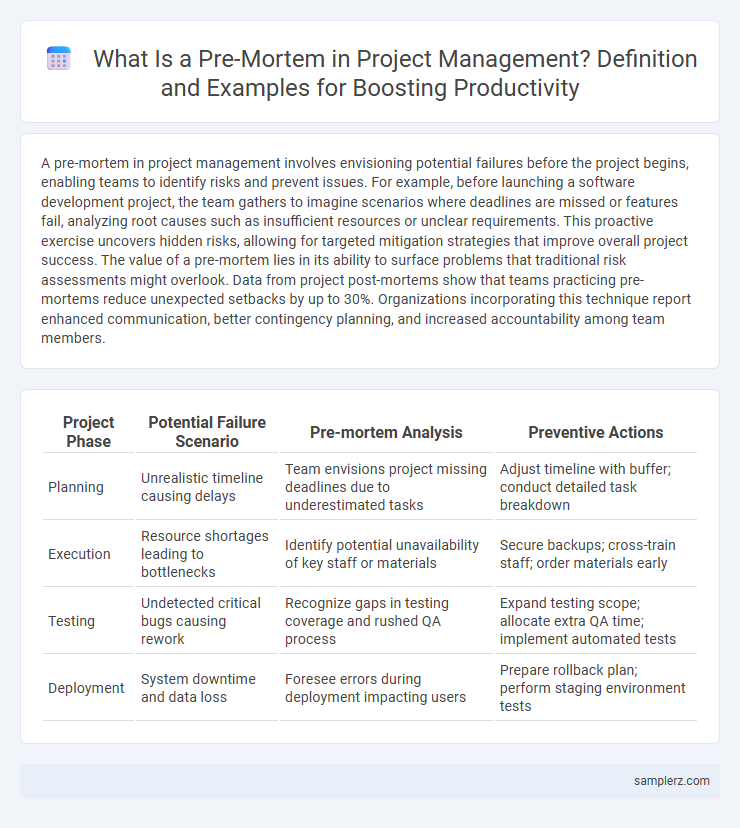A pre-mortem in project management involves envisioning potential failures before the project begins, enabling teams to identify risks and prevent issues. For example, before launching a software development project, the team gathers to imagine scenarios where deadlines are missed or features fail, analyzing root causes such as insufficient resources or unclear requirements. This proactive exercise uncovers hidden risks, allowing for targeted mitigation strategies that improve overall project success. The value of a pre-mortem lies in its ability to surface problems that traditional risk assessments might overlook. Data from project post-mortems show that teams practicing pre-mortems reduce unexpected setbacks by up to 30%. Organizations incorporating this technique report enhanced communication, better contingency planning, and increased accountability among team members.
Table of Comparison
| Project Phase | Potential Failure Scenario | Pre-mortem Analysis | Preventive Actions |
|---|---|---|---|
| Planning | Unrealistic timeline causing delays | Team envisions project missing deadlines due to underestimated tasks | Adjust timeline with buffer; conduct detailed task breakdown |
| Execution | Resource shortages leading to bottlenecks | Identify potential unavailability of key staff or materials | Secure backups; cross-train staff; order materials early |
| Testing | Undetected critical bugs causing rework | Recognize gaps in testing coverage and rushed QA process | Expand testing scope; allocate extra QA time; implement automated tests |
| Deployment | System downtime and data loss | Foresee errors during deployment impacting users | Prepare rollback plan; perform staging environment tests |
Understanding the Pre-Mortem Technique in Project Management
The pre-mortem technique in project management involves envisioning potential project failures before execution to identify risks and weaknesses proactively. Project teams gather to imagine a scenario where the project has failed and collaboratively analyze possible causes, enhancing risk mitigation strategies. This approach fosters a culture of anticipatory problem-solving and improves project outcomes by addressing vulnerabilities early.
Key Steps for Conducting a Pre-Mortem Analysis
Identifying potential project risks involves gathering the team to envision possible failure scenarios and listing all conceivable obstacles. Prioritize these risks by assessing their impact and likelihood, creating a focused risk mitigation strategy. Develop actionable solutions by brainstorming prevention tactics and contingency plans to enhance project resilience before execution begins.
Common Pre-Mortem Scenarios in Productivity Projects
Common pre-mortem scenarios in productivity projects include identifying risks such as resource allocation errors, unrealistic deadline estimates, and communication breakdowns among team members. By anticipating potential pitfalls like scope creep or technology failures, teams can develop mitigation strategies to avoid delays and inefficiencies. This proactive approach enhances project outcomes by ensuring early detection and resolution of obstacles that could compromise productivity goals.
Real-Life Pre-Mortem Example: Identifying Project Risks Early
A real-life pre-mortem example involves a software development team predicting potential failures before project launch by imagining a scenario where the product fails to meet client expectations. The team identifies risks such as unclear requirements, integration issues, and resource constraints early, allowing proactive mitigation strategies like enhanced communication protocols and contingency planning. This practice significantly reduces the likelihood of costly delays and enhances overall project success.
Pre-Mortem Exercise Template for Project Teams
A Pre-Mortem Exercise Template for Project Teams systematically identifies potential risks by envisioning project failure scenarios and analyzing their causes. This method enhances risk management by encouraging team members to proactively address weaknesses before project initiation. Implementing a structured pre-mortem template boosts decision-making efficiency and increases overall project success rates.
How Pre-Mortem Improves Project Outcomes
Conducting a pre-mortem analysis allows project teams to anticipate potential risks and challenges by visualizing possible points of failure before they occur. This proactive approach enhances decision-making, enabling adjustments that increase the likelihood of successful project completion. Studies show that projects utilizing pre-mortem techniques experience a 30% reduction in unforeseen obstacles and a 25% improvement in meeting deadlines.
Sample Pre-Mortem Discussion Questions
Sample pre-mortem discussion questions include identifying potential project risks by asking, "What could cause this project to fail?" Examining assumptions with questions like, "Which aspects of our plan rely on untested hypotheses?" and forecasting contingencies by considering, "How will we respond if key deadlines are missed?" These targeted inquiries enhance risk management and improve overall project success rates.
Lessons Learned from Pre-Mortem Sessions
Pre-mortem sessions reveal potential project risks by encouraging team members to imagine possible failures before they occur, which enhances proactive problem-solving and risk management strategies. Lessons learned include identifying hidden assumptions, improving communication channels, and refining project plans to address foreseeably critical issues. This practice boosts overall productivity by minimizing delays and increasing the likelihood of project success through early detection of flaws.
Pre-Mortem Case Study: Boosting Team Productivity
A pre-mortem session conducted with a software development team identified potential project risks that could delay delivery and reduce productivity. By envisioning failure scenarios, the team proactively addressed resource bottlenecks and communication breakdowns, resulting in a 20% increase in on-time task completion. This strategic foresight improved workflow efficiency and minimized rework, significantly boosting overall team productivity.
Best Practices for Facilitating a Pre-Mortem Workshop
Facilitating a pre-mortem workshop involves gathering key stakeholders early in the project to identify potential risks and failure points before they occur. Best practices include encouraging open, blame-free communication, using structured brainstorming techniques to uncover hidden threats, and prioritizing identified risks based on their potential impact and likelihood. Documenting insights and integrating them into the project plan enhances risk mitigation and improves overall project success rates.

example of pre-mortem in project Infographic
 samplerz.com
samplerz.com